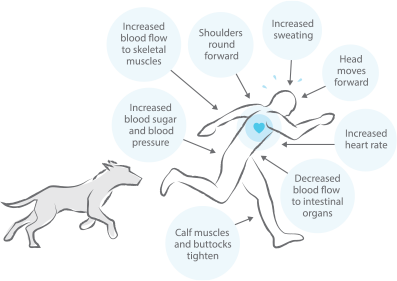Are you tired all the time?
Have tight shoulder and neck muscles?
Feeling anxious or depressed?
Have trouble regulating your temperature? (too hot or too cold)
Do you get regular headaches?
Do you have digestive troubles or hormonal issues?
Are you sensitive to light and sound?
Tight calf muscles?
If you answered yes to a few of those symptoms above, you may be suffering from what is known as Sympathetic Dominance.
Sympathetic what?
In order to get into what Sympathetic dominance is, first we need to talk about the branch of the nervous system it stems from.
To simplify it greatly, our nervous system has two key parts; The Sympathetic Division and the Parasympathetic Division.
 (Image from SDprotocol.com)
(Image from SDprotocol.com)
The sympathetic division is our in-built safety and survival (fight or flight) mechanism. If we are in danger (like if we have a lion chasing us) then our sympathetic system is activated, which suppresses our digestive system, reproductive system, immune system and the repair functions of your body. We don’t need these when our primary goal is to get away from danger that is threatening our survival, so our clever body ignores these functions in order to prioritise fuel for our muscles and alertness.
From an evolutionary perspective, this response is quite possibly the reason we are all still alive today. It is a natural and appropriate response to intense physical, mental or emotional stress. It means the body can adapt to situations that arise and ensures we have enough energy to get out of the “crisis” that is threatening our survival.
The problem we are experiencing in modern day life however, is that this survival mechanism is switching on too frequently and easily, and staying switched on for extended periods of time. This can cause a decline in overall health and contribute to a range of symptoms.
Why is the survival mechanism staying switched on?
In short, it is due to some aspects of our modern lifestyle. We have demanding jobs, busy schedules, we push the limits of ‘multi-tasking’ and have more financial stress. We have never-ending to-do lists, we lie awake at night worrying about mortgages, exams, interviews and relationships. We are constantly barraged by light and noise – when was the last time you were still and silent? With the increase in technology we are rarely alone and we’re not switching off. We are always contactable, distracted and are engaging in screen-time with poor posture. If it’s not one thing it’s another and all of these things mean we are living life in this “wound-up” state, even our children are unable to avoid it.
While some of us may love to go off the grid and get back to the old days, for most of us there is no avoiding the advances of modern technology. What we can control however, is the impact it has on our nervous systems.
How do we do this?
Thankfully there are many things we can do to switch off the sympathetic nervous system and limit its effect on our health. How far you go into it really depends on how long you have been stuck in sympathetic overdrive and how much stress you experience in your day to day life. There are a few simple things that apply to all of us though and the good news is that they are pretty easy to implement into our typical day!
We mentioned earlier the other part of our nervous system- the parasympathetic nervous system, this is the sympathetic nervous system’s chilled-out-herbal-tea-drinking-meditating-yogi sister. Where the sympathetic system winds us up, the parasympathetic system calms us down. This is the ‘rest and digest’ part of the nervous system where the magic happens – healing, sleeping, repair, growth, digestion, conception.. you name it!
By taking active steps to activate the parasympathetic system, we can help to switch off the sympathetic dominance we are experiencing.
How do we activate the parasympathetic nervous system?
- Getting adjusted
- Diaphragmatic Breathing (Deep Breathing)
- Meditating
- Stretching
- Exercising
- Spending time outside in nature
Other ways we can help to switch off the sympathetic nervous system
- Being aware of posture when using devices
- Switch off the screens! Challenge yourself to have a device-free day per week / month
- Be more strict with your “you time” – set boundaries and stick to them
- Avoid refined sugar and be aware of your food triggers and intolerances
- Stay hydrated with filtered water

